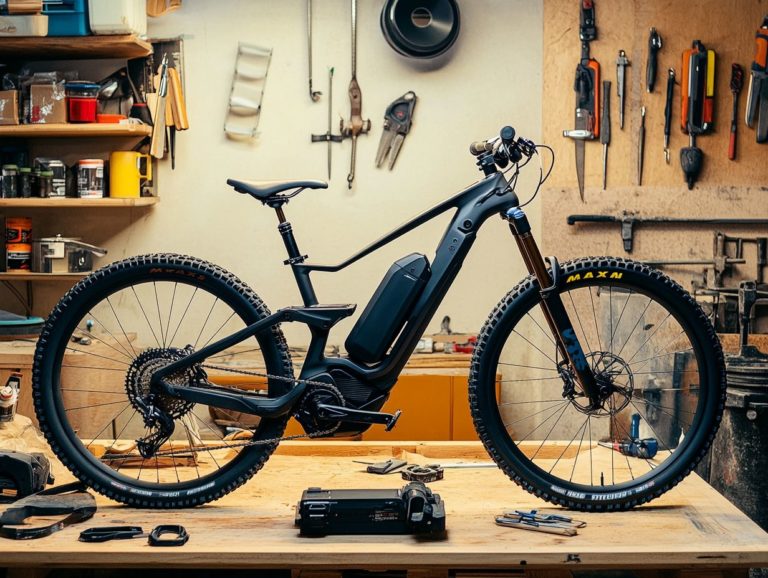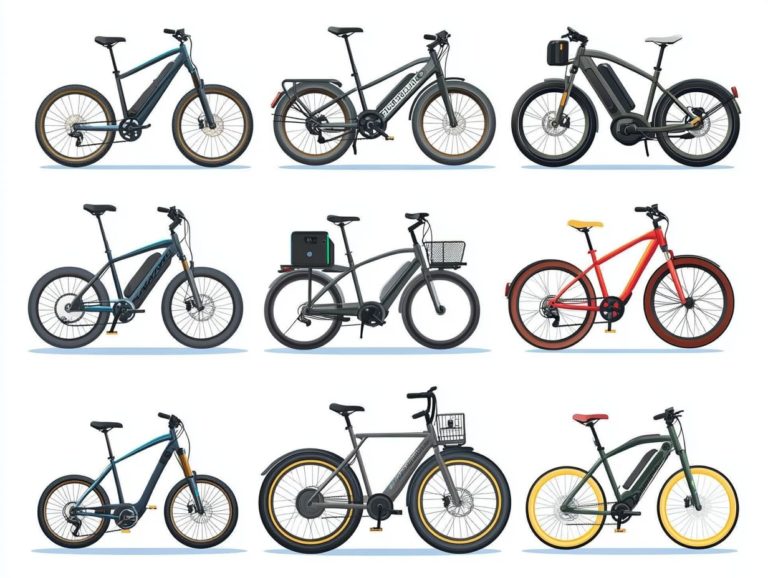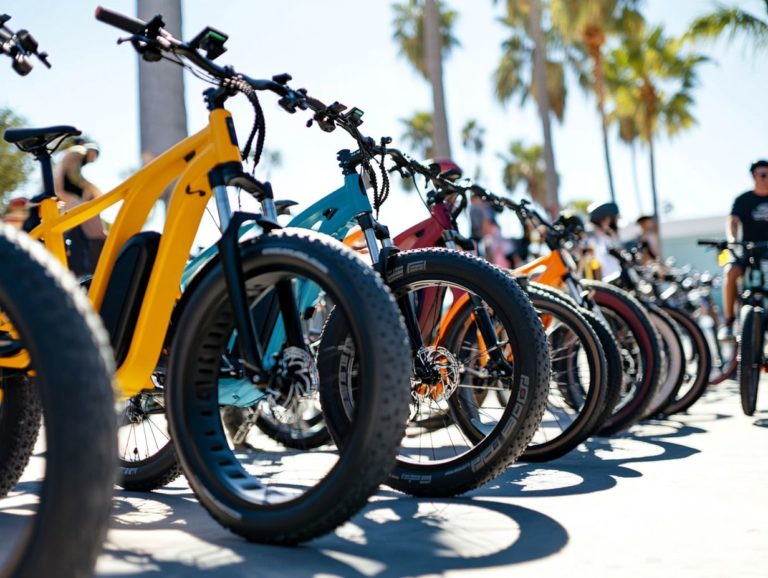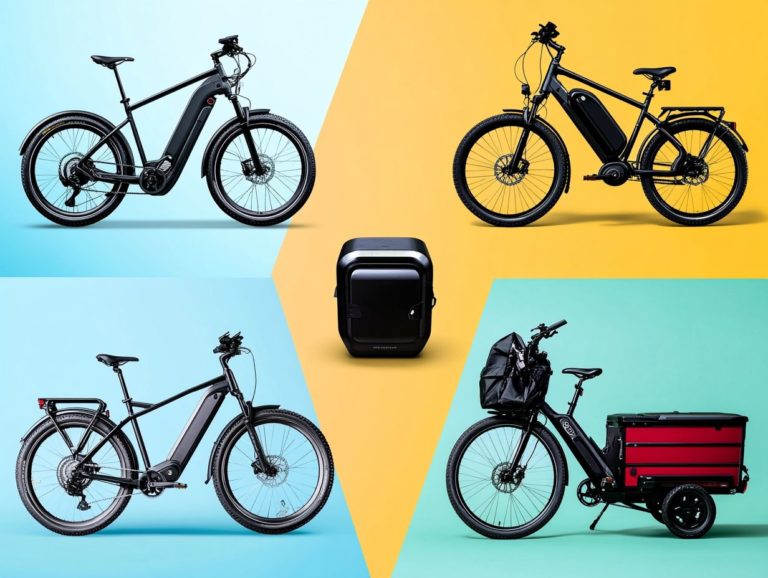Electric Bicycle Types: What You Need to Know
Electric bicycles have revolutionized the way you perceive cycling, presenting an engaging and eco-friendly alternative to traditional bikes.
With a variety of types available, understanding the classifications and differences will empower you to find the perfect match for your lifestyle.
Beyond mere convenience, electric bicycles offer a multitude of environmental and health benefits, all while delivering significant cost savings.
This guide outlines essential factors to consider when selecting an electric bike, as well as maintenance and safety tips to ensure your ride remains smooth and secure.
Dive into the world of electric bicycles and uncover how they can elevate your mobility and enhance your well-being. Don’t wait explore the benefits of e-bikes today!
Contents
Key Takeaways:
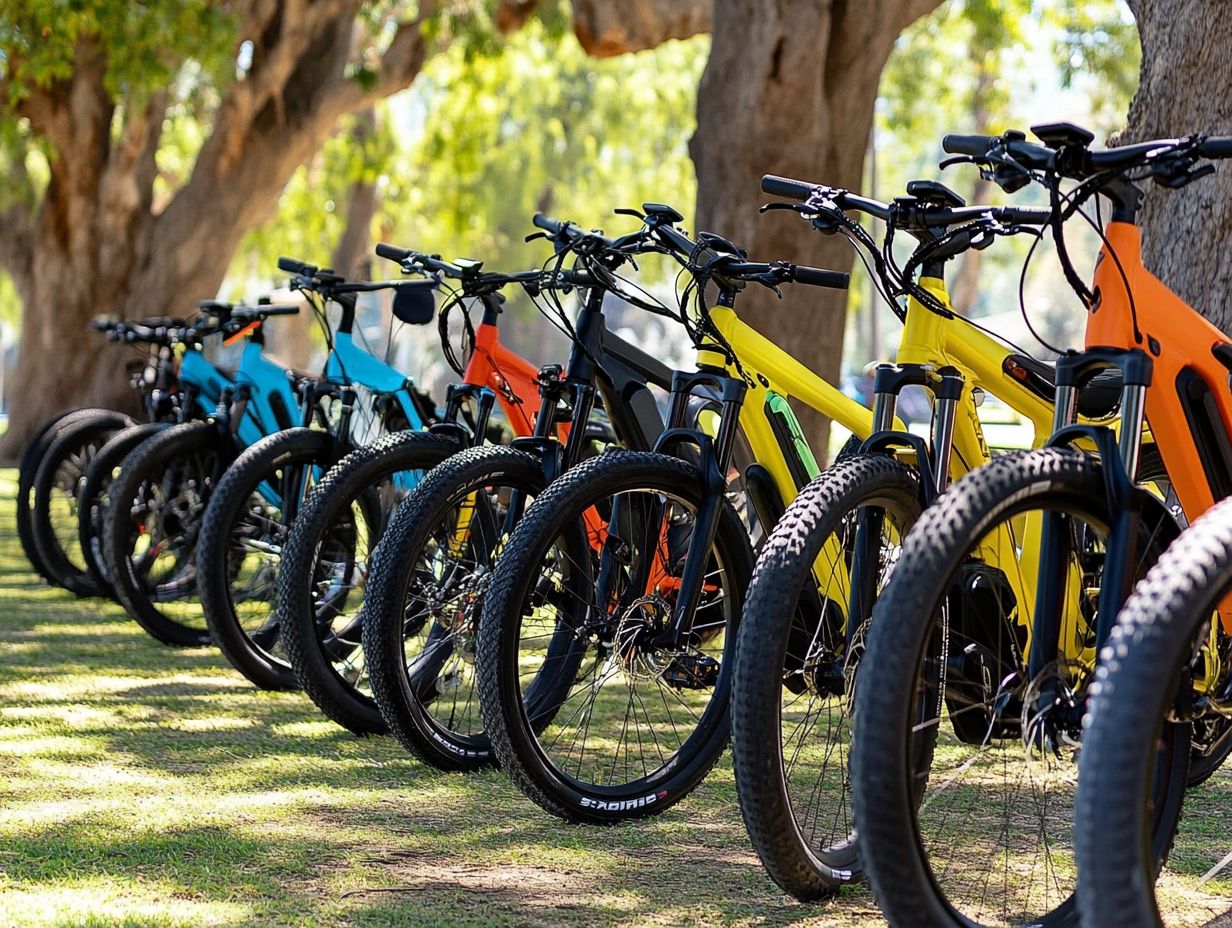
- Electric bicycles are a sustainable and cost-effective form of transportation, offering both environmental and health benefits.
- When choosing an electric bicycle, consider factors such as budget, terrain, and personal needs to ensure the best fit for your lifestyle.
- To keep your electric bicycle in top condition, follow maintenance and safety tips such as proper care and precautions.
What are Electric Bicycles?
Electric bicycles, or e-bikes as they re often called, represent a new way to approach transportation by mixing well electric motors with traditional cycling mechanics. This fusion allows you to experience enhanced speed and efficiency on your rides.
With pedal-assist systems which help you pedal offering varying levels of motor power, navigating urban commutes becomes a breeze, tailored to your riding style. Whether you prefer the subtle push of a Class 1 or the robust performance of a Class 3, e-bikes cater to a wide array of preferences and needs. For more insights, consider choosing the right electric bicycle type for you.
A typical e-bike features essential components such as a battery, motor, and control system, all synchronized to provide a smooth and enjoyable riding experience. You can opt for pedal-assist or throttle-assist options, personalizing your journey to match your comfort and desired exertion level. For those interested in exploring more, check out hybrid electric bicycles for a comprehensive overview.
Recent advancements in e-bike technology have introduced lightweight materials and more efficient batteries, significantly extending range while boosting performance. As these cutting-edge features gain popularity, more commuters and fitness enthusiasts are turning to e-bikes, drawn by their eco-friendliness and the convenience they offer in bustling city environments.
Types of Electric Bicycles
Electric bicycles are available in a range of types, primarily categorized into three classes: Class 1, Class 2, and Class 3. Each class is crafted to provide distinct riding experiences and adhere to specific regulations.
Class 1 e-bikes offer pedal-assist without a throttle, enhancing your cycling workout. Class 2 bikes, on the other hand, grant you throttle assistance for a more relaxed ride. For commuters, exploring the top 5 electric bicycle types for commuters can help you choose a Class 3 model designed for higher speeds, typically reserved for bike paths and roads, allowing you to zip along with confidence.
Classifications and Differences
Understanding the classifications of electric bicycles is crucial for you as a potential buyer, as the distinctions between Class 1, Class 2, and Class 3 e-bikes profoundly impact your riding experience and the legal regulations you’ll encounter.
Class 1 bikes offer pedal-assist support only, perfect for leisurely rides. Class 2 introduces both throttle assist and pedal-assist, providing you with added flexibility. Meanwhile, Class 3 takes it up a notch with higher speed capabilities. To learn more about these options, check out our resource on understanding different types of electric bicycles.
These differences dictate not only where you can legally ride each class but also influence your comfort and overall cycling experience. For example, Class 1 e-bikes, limited to a maximum speed of 20 mph, are often the go-to choice for relaxed rides along bike paths, ensuring a smooth experience without the stress of high speeds. If you’re considering longer journeys, it’s worth exploring the best types of electric bicycles for long rides to enhance your adventures.
Class 2 bikes, which allow for throttle-only operation, are particularly appealing for navigating bustling urban environments where quick bursts of speed come in handy.
If you’re more ambitious, Class 3 options cater to your adventurous spirit, offering longer travel ranges and enhanced versatility, perfect for commuting at higher speeds on roads. Grasping these nuances is essential for maximizing both comfort and efficiency across various environments.
Benefits of Electric Bicycles

Electric bicycles offer numerous benefits. They positively impact the environment, health, and economy.
By reducing reliance on gas and oil, e-bikes promote green travel options. They also provide a chance for riders to exercise, enhancing overall well-being.
Environmental and Health Benefits
Electric bicycles are amazing for our planet! They significantly reduce carbon footprints compared to traditional vehicles. Choosing e-bikes for urban commuting helps create a greener planet.
Fitness e-bikes not only promote sustainability but also encourage you to incorporate physical activity into your daily routine.
Opting for e-bikes instead of cars plays a vital role in reducing air pollution and decreasing reliance on fossil fuels. This aligns with global sustainability goals.
Beyond environmental advantages, fitness e-bikes cater to your health. They provide a low-impact yet effective way to engage in aerobic exercise. Regular cycling enhances cardiovascular health, boosts stamina, and improves overall well-being. This leads to reduced stress levels and a healthier lifestyle.
This dual benefit fostering green transportation while encouraging an active lifestyle makes e-bikes an attractive choice for modern urban dwellers. For more information, check out this quick guide on electric bicycle classification. Elevate your quality of life through long-distance riding while committing to the environment.
Cost Savings and Convenience
One of the most enticing advantages of electric bicycles is the significant cost savings they offer compared to traditional transportation methods. E-bikes reduce expenses tied to fuel, maintenance, and parking, making them an appealing option for savvy commuters.
When you compare the overall cost of e-bike ownership to that of cars, the economic benefits become clear. Car owners face ongoing costs for insurance, registration, and fuel expenses that can escalate quickly. In contrast, e-bike enthusiasts typically need a single upfront purchase and minimal upkeep.
Public transport fares can accumulate rapidly, especially for frequent riders. Electric bicycles empower you to glide past traffic jams and avoid the stress of exorbitant parking fees, creating a more effortless commuting experience.
Beyond financial perks, the benefits of e-bikes for the environment and health enhance their allure for urban travel.
Factors to Consider when Choosing an Electric Bicycle
Selecting the perfect electric bicycle requires careful consideration of various factors, such as your budget, the terrain you’ll navigate, and your unique riding preferences. These aspects can differ greatly among e-bike styles.
By understanding your intended use whether it’s for commuting, fitness, or long-distance adventures you can confidently choose an e-bike that perfectly aligns with your needs.
Budget, Terrain, and Personal Needs

When selecting your electric bicycle, it is essential to understand your budget, the terrain you will be navigating, and your unique needs. These factors are pivotal for achieving optimal ride efficiency and satisfaction.
The various e-bike components, such as motor power and bigger batteries that last longer, will significantly influence your decision.
Budgeting involves a meticulous analysis of the features that matter most to you against the range of price points available. If you are planning casual rides on flat urban roads, entry-level models might suffice.
However, if you are tackling rugged terrains, it is wise to invest in more advanced suspension systems and bigger batteries that last longer.
Your personal requirements, such as daily commuting distances or the ambition to tackle steep hills, also play a crucial role. These factors help you balance cost and performance, ensuring that your chosen e-bike aligns perfectly with both your riding style and budget constraints.
Maintenance and Safety Tips for Electric Bicycles
Keeping your electric bicycle in top shape is vital! This ensures it lasts longer and performs well on every ride. It is essential for you, as a rider, to grasp the nuances of proper care and essential safety tips.
Regularly tending to e-bike components like brakes, batteries, and tires ensures a seamless and enjoyable cycling experience.
Proper Care and Precautions
Proper care of your electric bicycle involves regular inspections and maintenance routines. These are crucial for both your safety and the longevity of your e-bike.
This includes checking essential components such as the batteries, brakes, and tires to ensure an optimal riding experience.
To keep your battery in top shape, periodically inspect the connections for any signs of corrosion. Make sure to store it in a cool, dry place when you are not riding. It’s also wise to keep the battery charged within the recommended range to help prolong its lifespan.
Regarding brakes, regularly checking for wear and ensuring they are properly aligned can prevent accidents and guarantee reliable stopping power. Tire health is equally important; check for proper inflation, examine the tread for wear, and keep an eye out for punctures.
While riding, adopting safety practices like wearing a helmet, opting for visible clothing, and making use of lights or reflectors greatly enhances your overall safety. This approach not only protects you but also creates a safer environment for everyone sharing the road.
Frequently Asked Questions
What are the different types of electric bicycles?
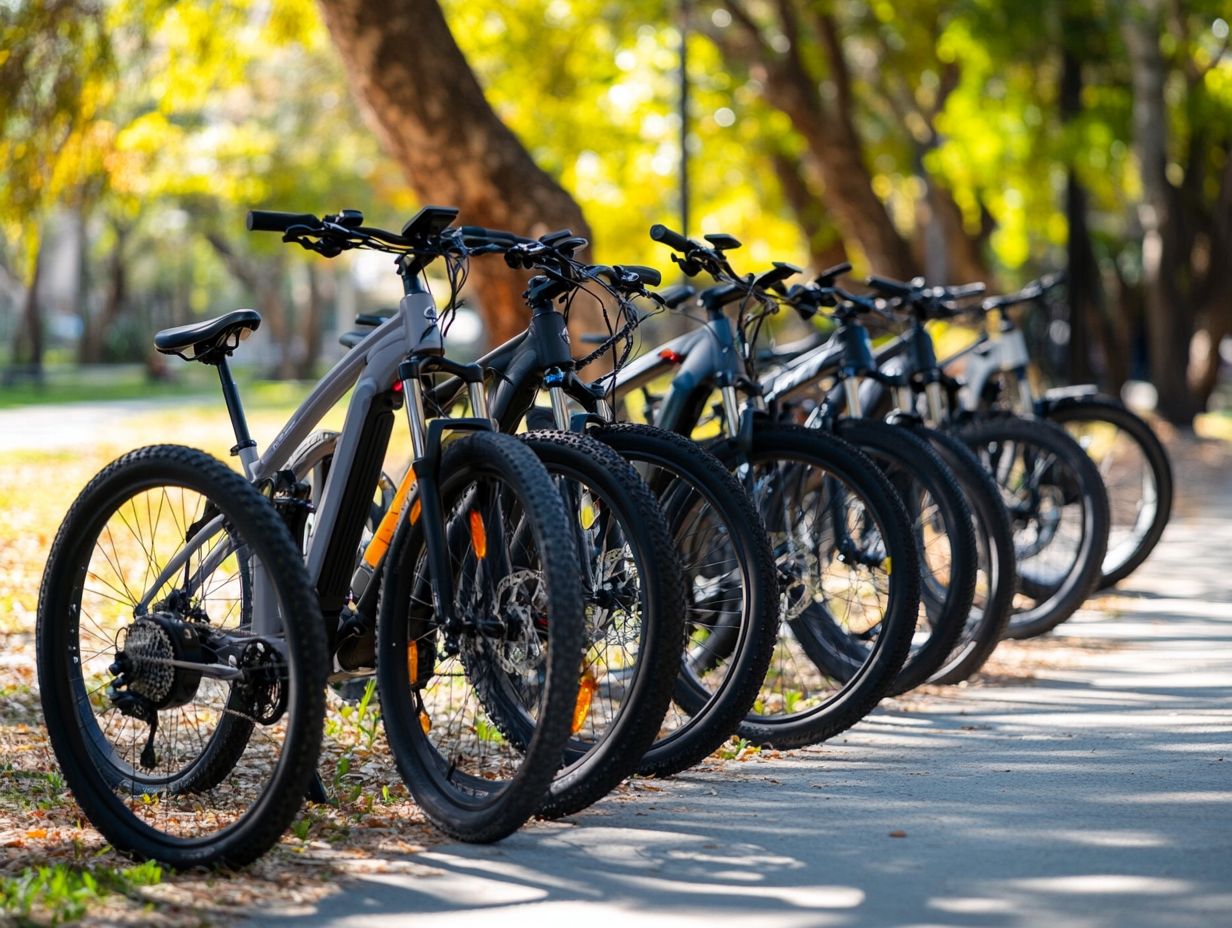
There are several types of electric bicycles, including pedal-assist or pedelec, throttle-controlled, folding, fat-tire, and step-through. Each type has its own unique features and is designed for different purposes.
What is a pedal-assist or pedelec electric bicycle?
A pedal-assist electric bicycle requires the rider to pedal in order for the motor to provide assistance. Pedelec means that the bike assists you as you pedal. This type of e-bike is popular among commuters and fitness enthusiasts.
What is a throttle-controlled electric bicycle?
A throttle-controlled electric bicycle allows the rider to control the speed of the bike using a throttle, similar to a motorcycle. This type is ideal for those who prefer a more laid-back riding experience.
What is a folding electric bicycle?
A folding electric bicycle is designed for easy transportation and storage. Its compact size makes it perfect for people who have limited space at home or need to carry their e-bike on public transportation.
What is a fat-tire electric bicycle?
A fat-tire electric bicycle is equipped with wider tires, providing stability and better traction on various terrains. This type is perfect for off-road adventures and outdoor enthusiasts.
What is a step-through electric bicycle?
A step-through electric bicycle has a low, step-through frame design, making it easier for riders to get on and off the bike. This type is great for those who have mobility issues or prefer a more comfortable riding position.
Start your routine checks today to enjoy safe and smooth rides tomorrow!

